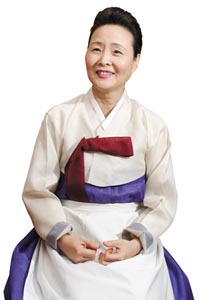For Caesar, the Rubicon was the turning point, for Yoon Sook-ja it was rice porridge
Interview with Yoon Sook-ja
Director, Institute of TraditionalKorean Food
"I thought it was just me being Korean. Naturally I grew up on that food, and so it's no surprise that my home food suited me perfectly. But that wasn't it. The more I studied about dishes of other countries -- China, Western etc., the more I became certain about the diverse, scientific methods our ancestors used to make food."
Thus spoke Yoon Sook-ja, and as anyone can guess from her job title, her biggest interest is studying Korean traditional cuisine that continues to form the basis for everyday meals in Korea. All those dishes with excellent nutrition prepared with love.
"My mother was from Gaeseong (in present day North Korea) and happened to be a great cook. There were always rice cakes and home-made liquors. It was my hobby to follow my mother around to see everything she did. Traditional food is like a home to me," she said, explaining her interest in restoring old recipes. She just couldn't stand seeing those warm, lovable, nutritious recipes for a homey atmosphere fade away.
That's why Yoon launched her big project -- the restoration of 151 kinds of traditional dishes described in "Jeungbosallimgyeongje." Written in 1766 by Joseon Dynasty scholar Yoo Jung-lim, it is a 16-volume collection that covers a broad social spectrum of everyday lives and the business affairs of commoners to nobles. Yoon has so far restored two complete volumes related to food. The process of translating the original Chinese characters to Hangeul (written Korean) and reviving the dishes took her six years.
It wasn't just the ancient expressions in the text that needed conversion: She had to battle the different measuring system used then and the difficulty of finding 18th century ingredients in the 21st century. This, her second labor of love, was as difficult as the first. She had also resurrected "Gyuhapchongseo" (1809), considered the first home encyclopedia of the Joseon Dynasty (1392-1910). Her efforts have reminded people of food culture traditions that were on the verge of extinction.
To review the old and learn newIn most cases the ancient art of cooking was passed down from one family to the other orally rather than in written words for it was looked down on as a "woman's thing." Director Yoon believes, however that as important as it is to develop new dishes it is crucial to re-collect the old recipes. Another task the director has put herself into is to collect the home recipes from Jongga Houses (traditional households in Korea linked by one eldest son to the other) and put them into writing. In a way that's her gift to the next-generation; a good diet that assures a healthy life style.
"One winter morning, my teacher cooked me rice porridge to comfort a stomachache. That got me thinking about the true meaning of food. It was a porridge made of rice cake mixed with all kinds of herbs. I realized that as long as we know our own food, we can combine ingredients to meet many different needs," Yoon said.
What stands at the center of her efforts to present convenient and sincere meals is a desire to bring out the pure taste of each dish rather than its sauce. The idea is also in touch with Korean traditional dishes that may not be aesthetically refined but are definitely able to nail down the right taste and beauty of natural food. That's the attitude Yoon has toward her life, too.
Intent on giving full satisfaction to her guests, her place is always ready with rice cakes in the freezer. (In addition to her work at the Institute of Tradtional Korean Food, she is also a professor/curator at the Tteok (rice cake) and Kitchen Utensil Museum in Seoul's Jongno-gu.)
Jilsiru Rice-cake caf?doing well, and her efforts to raise awareness about convenient and accurate recipe goes on. Thanks in part to her efforts, Korean dishes are slowly being introduced to cooks and diners far and wide.



























